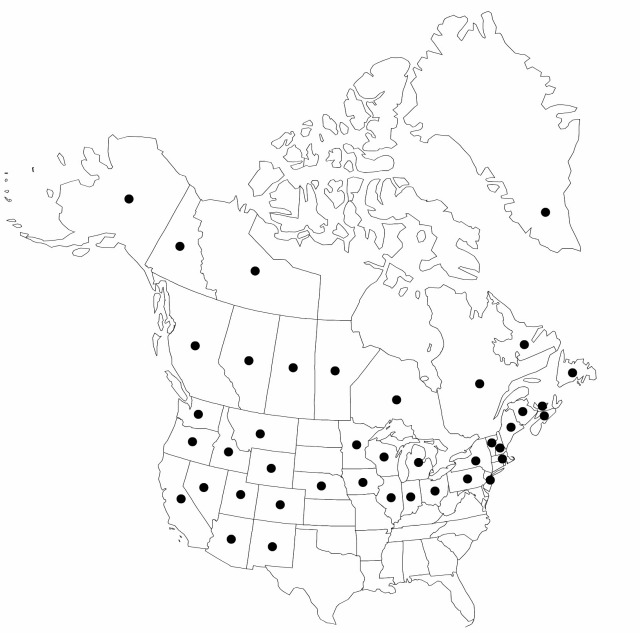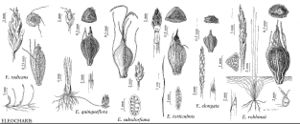Eleocharis quinqueflora
Mitt. Thüring. Bot. Ges. 1: 89. 1949.
Plants perennial; rhizomes 0.2–1 mm thick, scales persistent or fugaceous, 2–4(–7) mm, thinly membranous, not fibrous; resting buds often present on rhizomes or among culm bases, broadly to narrowly ovoid, 3–6(–10) × 2–5 mm; caudices absent, rarely present, soft or rarely hard, 0.5 mm thick. Culms erect, not spirally twisted, not contracted near spikelet, when dry usually with several blunt to acute ridges and sulcate, subterete to slightly compressed, to 2 times wider than thick, 5–35 cm × 0.2–0.5(–1.2) mm, soft to hard; culm tufts often proximally bulbous (if bulbous then tunicated by papery-fibrous scales). Leaves: distal leaf sheaths stramineous to brown or reddish proximally, green to stramineous or brown distally, membranous to papery, apex often reddish, subtruncate to acute. Spikelets 3–8 × 1.5–4 mm; proximal scale with a flower, seldom empty, 2–5 mm, 1/2 or more as long as spikelet; floral scales 3–10 per spikelet, 2.5–6 × 1.5–2.5 mm. Flowers: perianth bristles (0–)3–6, often unequal, rudimentary to equaling tubercle, stout to slender, spinules dense to apparently absent; anthers 1.5–2.7(–3.5) mm. Achenes stramineous to medium brown or gray-brown, equilaterally trigonous to compressed-trigonous, rarely some biconvex, obpyriform (to obovoid), 1.6–2.3 × 0.7–1.3 mm, beak variable. Tubercles rarely absent, 0.3–0.4 × 0.2–0.3 mm.
Phenology: Fruiting (spring–)summer.
Habitat: Fens, wet meadows, seeps, springs, hot springs
Elevation: 0–3600 m
Distribution

Greenland, Alta., B.C., Man., N.B., Nfld. and Labr., N.W.T., N.S., Ont., P.E.I., Que., Sask., Yukon, Alaska, Ariz., Calif., Colo., Idaho, Ill., Ind., Iowa, Maine, Mass., Mich., Minn., Mont., Nebr., Nev., N.H., N.J., N.Mex., N.Y., Ohio, Oreg., Pa., Utah, Vt., Wash., Wis., Wyo., Eurasia.
Discussion
The chromosome numbers for Eleocharis quinqueflora reported for North America (2n = 80) are in doubt because vouchers and other information are lacking. The often-cited n = 10 is probably erroneous. S.-O. Strandhede and R. M. T. Dahlgren (1968) gave 2n = 132 and 134 from Scandinavia. Recognition of infraspecific taxa within E. quinqueflora is premature pending a worldwide revision of subg. Zinserlingia. It has been reported from North Dakota, although I have not seen specimens. About five varieties and subspecies of E. quinqueflora have been described worldwide.
Most specimens from eastern North America and some from the West can be placed in Eleocharis quinqueflora subsp. fernaldii (Svenson) Hultén, which is characterized by its small size (culms to 15 cm × 0.5 mm) and small bulbs. Specimens of E. quinqueflora from 2000–3600 m in California, which are atypical, especially in that the proximal scales of the spikelets do not subtend flowers, may deserve taxonomic recognition. Those plants are also small, with culms only to 15 cm × 0.5 mm; hard caudices are often present at the culm-tuft bases; small, narrowly ovoid bulbs are sometimes present; and perianth bristles are absent or rudimentary. Very few specimens of E. quinqueflora are intermediate with E. suksdorfiana.
Selected References
None.
